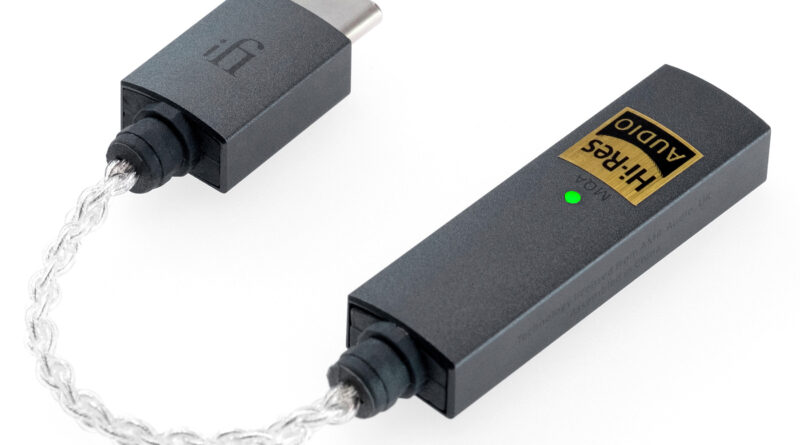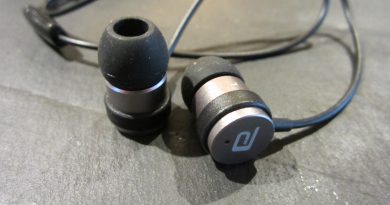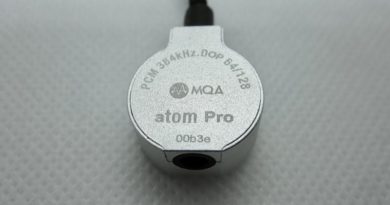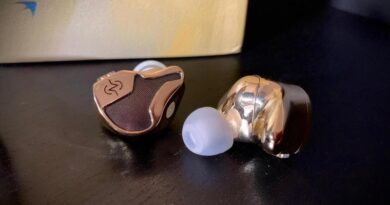iFi GO Link Review (1) – What More ?
As some may recall, I previously assessed iFi’s high end €329 dongle – the GO Bar. I guess there’s little doubt that when I took this € 59 (!) GO Link into consideration my first curiosity regarded such wide price positioning difference – quite evidently hinting towards a very different target audience intention…
In this Article
At-a-glance Card
| PROs | CONs |
| Stellar value | Third party adapter required for balanced-wired drivers |
| Broad host compatibility | UAPP or similar required for smooth volume control on Android |
| Supports both single and balanced ended drivers | |
| MQA rendering | |
| High res support (DSD 256 / PCM 384) |
Features and description
Externals
GO Link is seriously small and lightweight, really barely more conspicous than a mere passive USB cable, and much more flexible thanks to the braided structure given to its external wires.
It comes with a single LED on the chassis, which is supposed to indicate its power ON state while idle, and the resolution of the digital content being played while working, according to the following scheme:
| Green | PCM 44.1 / 48 / 88.2 / 96 KHz |
| Yellow | PCM 176.4 / 192 / 352.8 / 384 KHz |
| Cyan | DSD 64 / 128 |
| Blue | DSD 256 |
| Magenta | MQA |
On the main chassis a single 3.5mm phone output port is available. On the opposite end of the white braided cabling, a single USB-C male connector is present.
Lastly yet very importantly GO Link comes bundled with 2 USB accessories: a USB-C to USB-A adapter, and a USB-C to Lightning adapter.
The Lightning adapter in particular is a quite expensive item when purchased separately, and it’s a crucial resource for Apple ecosystem users as it perfectly matches iPhone and iPad requirements, thus avoiding them the need for the bulky Apple Camera Adapter.
Internals
Not diverting from their habits, iFi releases just macro-information about GO Link internals, but hardly any finer details.
GO Link is built around an ESS SOC-class chip, namely the ES9219MQ/Q (data sheet) which, within the inherent limitations of a SOC chip, is a quite interesting model. It features for example “QUAD DAC+” internal structure, which iFi exploits big time within their smart “S-Balanced” scheme (see more below).
Another ESS9219 feature which GO Link puts to good use is Dynamic Range Enhancement (“DRE”). In GO Link case this results into a 6dB DR enhancement, which is quite significant for a product in this price class.
The rest of the components are coming from the usual manufacturers normally enlisted by iFi, first and foremost Murata and TDK (capacitors).
Input
GO Link is a “pure DAC/AMP dongle”, so its sole accepted input is digital, via the USB connection.
As previously mentioned, the package includes a native USB-C male plug, a USB-A adapter and a Lightning adapter, which considering the very modest total asking price are a huge added value.
Output
GO Link’s sole output is its analog 3.5mm connector, which of course accepts any 3.5mm single-ended terminated load… and something else, thanks to iFi’s S-Balanced technology implemented behind it.
I already covered this iFi proprietary technology multiple times on my articles regarding other iFi sources (here, here and here). You can alternatively refer to iFi’s own white paper, here.
Simply put S-Balanced is a smart way to route the analog signal inside the device such to realise a sort of (give me some rope here) “fake” balanced scheme even with a single amp stage (vs two independent, parallel ones as they are used within “real” balanced schemes).
S-Balanced offers the same benefits of a true Balanced scheme in terms of lower noise and distortion, and none of its drawbacks (to know why… RTFWP!) when it is connected to a balanced-wired (TRRS) load.
In addition to that, unlike a true Balanced scheme, S-Balanced is fully backwards compatible with single-ended (TRS) terminated loads.
And more: single-ended (TRS) terminated drivers plugged onto an S-Balanced port will get “some” improved sound quality (50% reduced crosstalk) compared to the same dac-amp circuitry organised following the “ordinary” single-ended flow.
So you understood well: GO Link’s 3.5 output port (same as Nano iDSD Black Label’s, for that matter) does accept both single ended and balanced ended terminated IEMs/Headphones.
But… how do I connect a balanced-terminated cable (typically ending in a 2.5mm or 4.4mm male plug) to GO Link’s 3.5mm phone out? With an adapter of course !
Now for the really odd part: iFi does not provide such adapter – neither within GO Link’s standard bundle, nor even as a separately-purchaseable part.
Be as it may, the 3.5 mm TRRS wiring you want is what is also called “Hifiman standard”. See here for reference.
I do have such an adapter (3.5mm TRRS male, 4.4mm TRRS female) from back in the days when I was using the Nano iDSD BL, and I can relate the “trick” does work: pairing the same balanced-wired IEM to GO Link once via a 4.4 to 3.5 TRS single ended adapter, and then via the 4.4 to 3.5 TRRS adapter, results in an obviously improved sound in the latter case.
Host power requirements
GO Link absorbs 1W = 450mA (max) while playing and 0.7W = 375mA while idle.
These are not the lowest figures in the industry – the champs always being the Dragonflys here, followed by E1DA 9038SG3 and 9038D – yet these are still to be considered quite modest values, which won’t make too quick shame of your phone’s battery. Yes, iPhones included (via the Lightning adapter supplied as a freebie).
Volume and gain control
GO Link does not offer a physical on-device volume control. Its volume control is interfaced with the one on the host platform (I positively experienced Windows and Android).
The situation is potentially problematic on Android which – by default – divides the USB device volume range in only 40 steps (or even 25 for the latest Android releases…), resulting in the last ticks converting into way too big SPL variations.
Luckily, those better featured player apps (e.g. UAPP) which you would normally anyway use for a number of other reasons one above all bypassing standard Android audio drivers do also allow for re-defining the number of steps Volume control is divided into (up to 250, on UAPP) – which solves the issue.
Other features
MQA Rendering
I won’t spend a word on what MQA itself is, of course. Google around if you wish and you’ll be overflooded with info.
What matters here is: GO Link is a “MQA Renderer”, so it can fully unfold MQA tracks on its own hardware, which is an upgrade vs the default represented by having the music player host do the unfolding, and only limited to the first 2 folds.
Singers/players/bands/publishers record their tracks, and eventually release their albums. Prior to the digital music distribution era, there could be very little doubt about whether the music we were listening to was the “original” version of that album as its creator/publisher intended or not; if we had a legit copy of that LP or of that CD, that was it.
In the digital music distribution system, instead, the end user has no “solid” way to make absolutely sure that he’s receiving an unaltered version of those tracks. For what he knows, he might be getting a subsequently remastered, equalised, anyhow manipulated version of that album.
The MQA offers a way to “certify” this. An “MQA Studio” track is a file which containes some sort of “certification codes” that guarantee that track is indeed “the original” as released by the authors. A sort of digital signature, if you wish. Anyone might process, EQ, remaster, etc, that track, and re-encode it under MQA but the new file wouldn’t carry the original author signature anymore.
“MQA Original Sample Rate” (a.k.a. “MQB”) tracks are MQA Studio Tracks for which a further certification is given that not even the mere sample rate has been altered (in particular: oversampled) compared to the “original version” as released by the authors.
Any MQA-capable device can play back all MQA encoded tracks, but only MQA Full Decoders are able to identify such additional “digital signatures” and tell the user “hey, this is an original track” or not.
Ifi GO Bar, Gryphon, HipDac-2 are all Full Decoder devices. Ifi GO Link, HipDac, Micro iDSD Signature, Nano iDSD Black Label are Renderers.
Between parentheses: HipDac and HipDac-2 being virtually identical in terms of sound capabilities, power, etc, with the sole major difference represented by their different MQA capabilities, offered me the interesting opportunity to check the differences on a quite similar if not virtually identical situation and I could tell a quite obvious SQ improvement when listening to a few particular tracks just Rendered (HipDac) or Full Decoded (HipDac-2).
That said, I don’t personally care about MQA, nor about any of the existing digital distribution catalogues for that matter, due to the fundamental lack of good editions of the music I prefer on there.
Firmware
Like all other iFi devices (well at least all those I know of, but the list seems quite comprehensive…), GO Link allows for the user to easily change/upgrade the device firmware.
At present time, on GO Link this option can only be actionated with the purpose of installing incremental firmware updates aimed at feature optimisations or bug fixing.
Package
I already covered this en passant above, but for the sake of completeness: GO Link comes in a small box but with the right bundle accessories, and premium quality ones at that too.
- USBC-Lightning passthrough adapter
- USBC-USBA passthrough adapter
Sound and power
GO Link sound quality is basically in line with what one would expect from a latest generation ESS SOC chip – such as what you get off of a Shanling M0 Pro, which I recently reviewed – with some little bit of further enhancement.
Who wants to go the extra mile is cordially encouraged to get a TRRS 3.5mm adapter and plug balanced-terminated drivers onto the GO Link. The improvement in terms of noise reduction, clarity, stage drawing and imaging will be quite obvious.
GO Link’s output power is not huge yet not weak either: it delivers 2V on high impedance loads (300+ ohms) and 1.5V (70mW) onto 32 ohm loads, making it an absolutely viable option for 95+% of the IEMs out there and much of the cans, too. Just avoid planars, and particularly current-hungry IEMs (E5000, B1…), and you’re a happy camper.
Considerations & conclusions
With the GO Link, positioned at just € 59 EU retail, iFi clearly aims at marketing a ultra-portable, not-necessarily-audiophile-tier “smartphone audio upgrade” device, offering all users of no-wired-analog-out phones an option to plug their wired drivers, and a sound quality and/or output power upgrade to all others.
After assessing it I can relate that iFi indeed went much, much beyond such intention.
While surely south of the top dongle market levels reached by the likes of Questyle M15, Apogee Groove, Dragonfly Cobalt and iFi’s own GO Bar, iFi GO Link offers very interesting output quality and power, full MQA rendering, instant matching with Windows, Android and/or Apple hosts, and even an extra option to pair with balanced-terminated drivers (via a third party adapter) for even wider compatibility, and even better sound.
What more an occasional user might ask for € 59 retail I frankly wouldn’t know.
Our generic standard disclaimer.







